In San Francisco’s Haight-Ashbury district, youth homelessness is impossible to overlook. Spend any time in the neighborhood, and you’ll notice that hundreds of “street kids” – young homeless in their teens and twenties toting large backpacks and sleeping bags – call Haight Street and Golden Gate Park their home.
In this neighborhood, street kids are a constant presence. They hang out on most corners, asking for spare change or leftover food, smoking weed, and occasionally proffering drugs for sale. The area is famous as the epicenter of the 1960s hippy movement, but the street kids mix uneasily with today’s gentrified Haight – an area of $1,500 rents, trendy nightspots, and Google buses whisking engineers away for the workday. Even in a city known for homelessness, they stand out as unusually young and numerous.

Encountering San Francisco’s street kids can prompt uncomfortable reactions: guilt and pity at the sight of their poverty, unease with their drug dealing, even nervousness and fear due to their unpredictability, uncouth appearances, and penchant for vicious-looking dogs. It is easiest to ignore them, and most locals admit that they have never had a conversation with them.
At Priceonomics, we wanted to know more about these street kids that we see everyday but know almost nothing about. Who are they? How do they make money and how do they get by? Why are they here? So, we decided to ask them.
Our initial hypothesis was that life on Haight Street would be a grim, Dickensian hellhole. Instead, we discovered a world of misunderstood, modern-day nomads, blithely toeing the line between poverty, drug dealing, and hippy nirvana. Most of them seemed to be having fun.
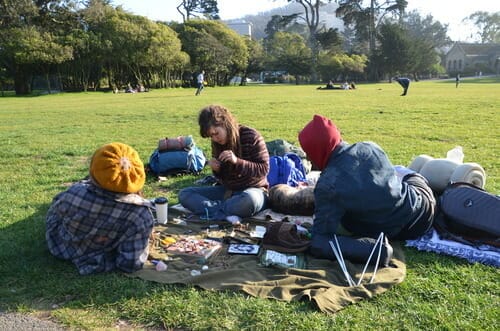
Down and Out in San Francisco?
On most nights, street kids huddle in their sleeping bags with no shelter except the side of a building or the landscaping of nearby Golden Gate and Buena Vista Parks. To us this seems like a pretty rough situation, to be avoided by any means necessary. But as we interviewed them, a different picture arose.
Most street kids we spoke to came from one of two backgrounds: either they had job prospects (whether good or dead-end) but preferred the freedom of homelessness, or were transient homeless who fell in love with the street kid community.
Kenny, who we met in Golden Gate Park, represents the former. Middle-aged, he is a ten-year veteran of the scene. His story of arriving in Haight-Ashbury unfolds like the tale of Siddhartha:
“My family owns a major medevac company. We were affluent, well off. My wife and I were both pursuing PhDs when she asked for a divorce and it tore my life apart. In the process of re-examining everything I took for granted, I decided to come here.”
After recounting the story of his weed farm (and spending 75 days in prison when it got busted), he pulled out books ranging from Martin Luther to Eastern mysticism, each protected by a zip lock bag, and derided time working as time not spent experiencing the divine. “The tree of life is real. I didn’t recognize it when I first started meditating, but it exists.”
Kenny’s story is an extreme case, but he is not the only one who left a comfortable existence for the freedom of the Haight. A number had college degrees or left jobs in retail and construction.
Stephan, the very first street kid we met, represents the second background:
“My mom kicked me out of the house at 14 and gave me a ticket to my aunt’s place in Florida. As I was waiting for the bus, a van full of Grateful Dead groupies pulled up. ‘We’re here for you,’ they told me. I got in. They became my family.”
Like a number of street kids, he found the Haight through its significant overlap with the Grateful Dead groupie scene. (The Grateful Dead lived in Haight-Ashbury in the sixties, performed during the Summer of Love, and inspired the trend of following bands from concert to concert.)
Each street kid like Stephan had a different story for how they became transient: Nix hated moving foster home to foster home and decided to run away. Ritch lost his job and apartment in New York due to a heroin addiction and began hitchhiking. Brand discovered the scene after his friends sold his mobile home for drugs and he fled the law across state lines.
But they all stayed for the same reason: They found a community where “people will give you the shirt off their back,” where everyone is accepted, and where people share and live communally. The word “family” is repeated a lot.
Especially for those with mental problems or those who felt scorned elsewhere, the accepting attitudes and communal lifestyle offer a place for them to feel at home. Along with the popularity of tie-dye, Grateful Dead tee shirts, and dreadlocks among the street kids, it also points to the connection between the street kids and Haight-Ashbury’s hippie past. Street kids defied our expectations of living on the street as a last resort; instead they seem to be drawn to the Haight.
Pressed on why he lives here, Stephan blurted out, “The park is magic.” If he is thirsty, he said, someone appears with a drink. If he forgets his pack, someone will guard his possessions.
We did not have to wait long for a demonstration. Stephan admitted to being stressed since his mother died in North Carolina three days ago. Douglas, a mortician who hangs out in Golden Gate Park after work (“for the weed and the beautiful women”) piped up: “You can go home, you know. Homeward Bound. If you have proof of your mom’s death, they’ll get you bus tickets home. I’ll take you to their office tomorrow.”
Douglas turned, his smile matching the white of his 49ers cap, “You see? That’s why I’m here today. God put me here to help him get home.”
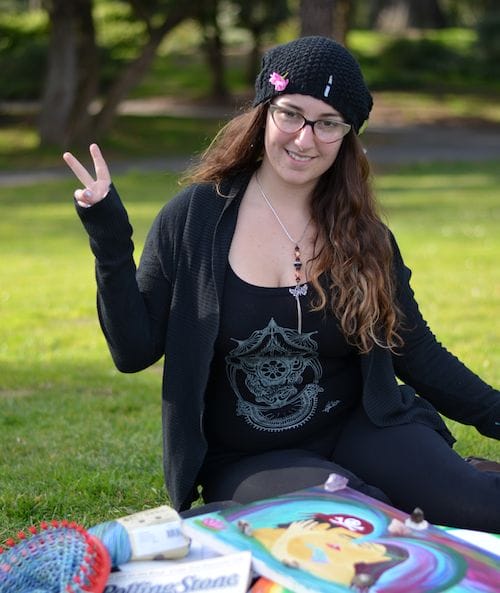
The Personal Finances of Homeless Street Kids
Whenever Haight Street tourists or bar hoppers crowd the neighborhood, street kids panhandle (hold a palm out for money – resembling a pan handle) and spange (“Spare change?”). An average day of spanging brings in about $40. But with some luck and creative tactics (jumping out of trash cans to scare a group of teenagers, or telling tourists how to take the perfect picture of the Haight and Ashbury street signs), a day’s haul can break into triple digits.
This struck us as a good deal of money for the homeless. The street kids disagreed. “I have a spot downtown where I can make $50 an hour,” one girl told us. “But I try and respect the spot and not go too often.” Others added that spanging elsewhere easily brings in triple digits every day. Yet they still panhandle in the Haight even though it’s not their most profitable location.
Selling marijuana is also a consistent source of income for many street kids. They sell weed to a diverse customer base, from tourists to local yuppies and other peddlers, so the amount they make per transaction varies. Tourists may pay two or three times more than a local. Street kids consistently describe making several hundred to a thousand dollars a month and profit margins as high as 50%. We even met a shrewd kid named Swirly selling weed to pay his girlfriend’s tuition.
Aside from drug dealing and panhandling, a few kids occasionally receive money from their families, while others use food stamp cards. But the majority insist on supporting themselves, and even refuse to spange. Many kids make necklaces or other trinkets out of gemstones, but they seem more interested in talking about their properties and trading them with other street kids than selling them profitably to tourists.
Many of the kids get part time jobs in construction, in landscaping, or at music festivals, but these jobs are just a temporary “break.” Employment and income is a fun change of pace from the Haight, but it’s not as if they’re antsy to escape their homeless situation.
The homeless youth told us repeatedly, “We only try to make enough to get by,” but it proved impossible to determine what was “enough.” Our questions about daily expenses were treated as almost nonsensical. Street kids described purchases – $3 teas from Whole Foods, $18.99 dog food from an organic pet store, $10 black bean salads from a local market – that made little sense for impoverished people and followed little discernible pattern.
The amount of time devoted to selling or busking also varied with little connection to profit or need. When we asked how much money they needed to earn, we received answers like, “Well, if I need a new guitar string then I’ll busk until I have enough to pay for that.”
A street kid named Sway enlightened us in between plucks on a guitar: “We get enough food from leftovers and shelters. You only need money to buy beer, weed, and dank food.”
We thought we’d find kids living in Haight-Ashbury as a desperate last resort because they were impoverished. Instead, we found that many were exactly where they want to be and were voluntarily choosing to make just enough money to subsist on the streets.
By meeting their basic needs through dumpster diving and charity, and not desiring much more, the street kids feel no need to make more money, even though they could. Most of them could clean up and leave the park whenever they wanted, but here they are free from pressures of the formal economy like showing up to work or paying rent. It’s a scenario they prefer, it turns out, because most of them are devout hippies.
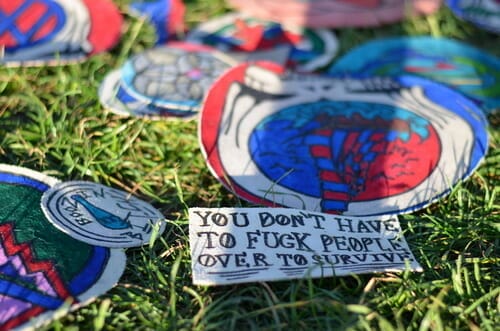
The Hippies’ Successors
While sitting with a group of street kids in Golden Gate Park, a tour guide pointed at us. “The hippies!” he yelled gleefully. Dutifully, the street kids flashed peace signs and yelled, “Come smoke with us!” A kid name Erie tells us:
“We want to make a statement by living an alternative lifestyle. A smoother one that’s easier on us and easier on the earth. We trade and barter. We don’t want to use money.”
In 1967, the hippy movement crested as the Summer of Love hit San Francisco. In an era of consumerism, the Vietnam War, and the civil rights movement, the hippies rejected materialism, racism, social inhibitions, and war. They embraced communal living, music, and LSD to achieve peace and love. Attracted by the promise of drugs, psychedelic concerts, and social revolution, tens of thousands invaded Golden Gate Park.
Today, the street kids do not denounce drone strikes, bailouts, and standing in line for the iPhone 5. Nor do they proselytize. But they do follow hippy values.
While we were there, a crew on “Hippie Hill” made necklaces and spiritual “talismans,” and traded them for drugs and food. Kids complimented each other on their aura. They smoked weed, lit incense, and shared with strangers. (We turned down offers of free weed, LSD, and spicy sauerkraut.) A number spoke reverently of attending Rainbow Gatherings – events which are to hippies as Las Vegas New Year’s Eve parties are to fraternity brothers. And in pursuit of a communal lifestyle, we saw street kids share weed and scavenged food, pool money to buy beer, and follow a code of balanced giving and taking best summed up as “from each according to his ability, to each according to his need.”
At one point we asked a street kid named Laramy why he comes to Golden Gate Park long after its heyday ended. He looked up from the Grateful Dead patches he was selling toward the 30 person drum circle performing for a crowd on Hippie Hill. “Who says it’s over?”
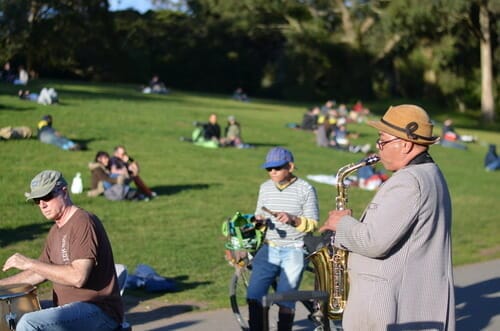
The Hippy Hub of the Northwest
After the disappointing end of the hippy movement, a number of them switched from trying to change the world to creating small communities that followed their values. They started collectives, weed farms, and music festivals. It’s all part of the scene for these kids.
– Kenny, veteran of Haight Street
The street kids are nomads, hitchhiking and hopping rail cars, on the move between music festivals, national parks, weed farms, and other meeting places where members of “the tribes” gather to chill, sell drugs, and bum life’s necessities.
They benefit from the infrastructure set up by “the elders”: veterans of the hippy movement who first gave them weed to flip, hired them at festivals, and included them in collectives and weed farms.
Their scene also bleeds into the wider and mostly invisible world of America’s transient underclass, unemployed and underemployed street people locked out of much of the job market. We met a number of kids who described working full-time jobs that barely paid for crappy apartments and canned food. Why, these upwardly immobile asked, should they work for a deadening existence when they can dumpster dive and panhandle their way around the United States and even the world?
Bit by bit, street kids revealed a secret, parallel lifestyle:
Joe Camel described driving to a trade/barter festival in Oregon, filling up the tank by showing up at gas stations with an empty gas can, smiling, and asking, “Can you spare some gas?”
Nix dreamed of travelling Europe and hanging out in the squatter communities of Paris.
David was excited that someone had offered him space to grow at a weed farm in Humboldt County, and Leftovers explained that he would soon head up to a farm in Mendocino where he would be paid in beer, food, and weed.
Sway told us that music festivals near Portland have lenient security that allows street kids to talk their way in.
Ritch described running into street kids he met in Haight-Ashbury in New York and at truck stops across the country. He also pulled back the curtain on the names – street kids meet so many people in their nomadic community that it’s better to create unique names.
In many ways, the street kids seemed to be having a lot more fun than us.
The Hippy Mafia
The street kids describe themselves as “family.” This reflects their hippy inclinations, but it is also a trademark of street gangs that band together to survive.
The street kids’ equitable sharing of the resources seems uncharacteristic of street gangs, which distribute resources and power in vertical hierarchies (according to our understanding as avid watchers of The Sopranos). Nevertheless, a cheerful kid named Joe Camel explained to us, there is a street kid hierarchy. Those who have been in the family longest can hustle potential customers at the start of Golden Gate Park – the prime real estate – whereas new kids start farther back in the park.
Similarly, kids’ connection to the family determines the price they receive on drugs. Although street kids mostly sell weed, Joe gave the example of LSD, which sells for up to $20 a hit on the street. A street kid can buy a small container for $300, or $150 if he or she is really an insider, and flip it for $600.
The park has gotten rougher over the past decade, so the family has too. Kenny, the former PhD, described how ten years ago, hippy street kids profitably sold weed to clamoring customers and comfortably financed their wanderings to the next music festival. But as the price has dropped – in half over ten years, according to Kenny, due to legal dispensaries and new sellers – kids need to hustle business and competition is fierce.
Street kids can hitch across the country, but their territory in Golden Gate Park is strictly defined. Kids smoking near Hippy Hill pointed to a tree fifty yards away. If they tried to sell weed there, street kids belonging to a gang called the San Francisco Scum Fucks would beat them up. The Fillmore Kids, who sell near the park entrance, have also picked fights.
Violence rarely exceeds fists, but street kids can’t rely on peace and love. Not only are there outsider gangs, but the more time we spent in the park, the more street kids we met who came to Haight-Ashbury as part of the transient community and feel no affinity for the neighborhood’s past. “There are fights in the park,” one kid told us, shaking off the idea of being a hippy and pointing to the brace on his foot. “I literally, literally broke my foot on someone’s ass in a fight. It’s not a good time for the park.”
The kids despise the police, so the family also enforces its own rules. Momma Jude, who plays a motherly role for the kids, recalled the family throwing kids who robbed or fought into nearby “Hep-C” Pond (named for the hundreds of syringes coating the bottom) before telling them to scram.
Momma Jude hurled insult after insult at the nearby cops, but suddenly she focused her attention, with the steely gaze the police use on street kids, on a shabby looking man crossing the street in jerky motions. “That’s a tweaker,” she said. “He’s on speed. And crazy. If he comes back, we’ll chase him away.” Despite their best efforts, however, people on hard drugs are invading the park. “It used to be that tweakers and whatnot weren’t allowed in the park. But now they’re all over.”
Separated at night as they seek a spot to sleep, the street kids are vulnerable as lone gazelles. They are robbed so often that they often resort to hiding hundreds of dollars under trashcans. And while they warn each other when someone has been knifed in the park, no one has any idea what to do other than “be careful.”
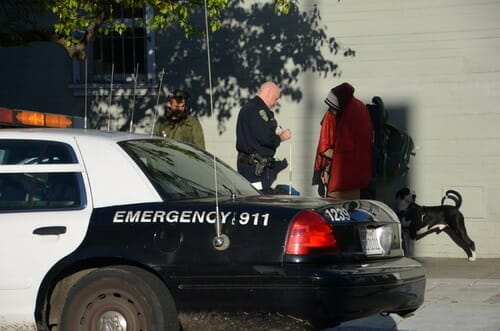
Gutter Punks
People assume the worst about street kids, and treat them accordingly.
In 2010, San Francisco voters passed a sit/lie ordinance that forbids anyone from sitting or lying on the sidewalk between the hours of 7am and 11pm. Residents and merchants of the Haight pushed for it to target the street kids, and former San Francisco mayor Gavin Newsom decided to support the ordinance after he and his 5-year-old daughter saw a man smoking crack on the Haight Street sidewalk.
The street kids stress that they oppose the rabble that smoke crack and vandalize the neighborhood just as much as anyone in the Haight. But people associate the street kids with the worst aspects of street life. So now, the kids say, “The pigs [police] drive through Golden Gate Park and Haight Street at 6:30 every morning, waking us up so they can pretend that there are no homeless on the street.”
Nix, the foster care runaway, noted, “People think they can say anything to the homeless.” She described asking for money from a couple in downtown San Francisco. The woman assailed Nix with a shockingly nasty retort, too sexually explicit and demeaning to print on the Priceonomics Blog.
One morning we stood outside a laundromat with two street kids looking to wash their clothes. The door was locked, but they did not have a timepiece to check whether it was time for the laundromat to open. Spying a local resident exiting a garage with her bike, one of the kids yelled, “Do you know what time it is?!” Obviously bewildered, she did not respond. “I know!” the street kid yelled, used to being ignored. “I’m an inchworm! I know I’m an inchworm!”
In Pursuit of the 4-Hour Workweek
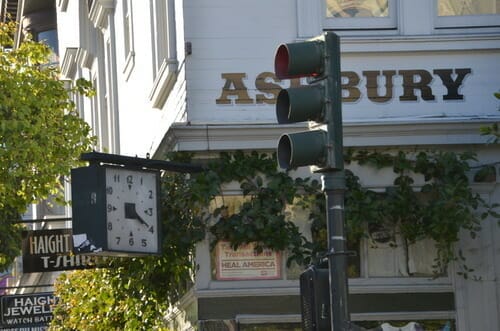
We asked street kids who felt strongly about living an alternative lifestyle whether it bothered them that their scrounging and spanging relies on the capitalist system. But Nix’s comments turned the question back on us:
“What does it say about this country that I can eat like a queen from a trashcan in a mall food court? Or that when students move out of their dorms, they throw out more food than I can eat, no matter how many friends I bring? Or that police arrest people for eating food from the trash?”
The street kids don’t evangelize about the evils of work and money, but if you ask, they present a compelling case for giving it up.
Sway’s face lit up talking about a Ben Harper concert where both the crowd and police lit up joints with him during a set (“He legalized marijuana in California for ten minutes by himself!”), as well as his progress hiking the Pacific Crest Trail from Canada to Mexico. When he compares this to the dead end jobs that awaited him after college, it is hard to argue that he made the wrong choice.
Kenny, whose family owns a major medevac company, reflected that he pities his affluent family members for working long hours to buy things they don’t need.
Street kid life in San Francisco is not all a Kerouac utopia. They experience crime and gang violence, suffer through cold nights, risk overdosing without access to medical help, and have limited options when they get too old for the lifestyle. But in a city that lionizes entrepreneurs who sacrifice everything to create the next big thing, there is something admirable about the street kids’ total embrace of drugs, freedom, and a lifestyle that society scorns.
This post was written by Alex Mayyasi. Follow him on Twitter here or Google. Thanks to the young folks of Haight Street who were so kind to answer our questions and pose for pictures.



